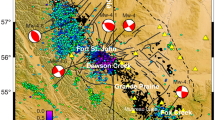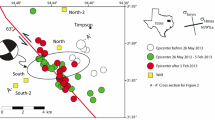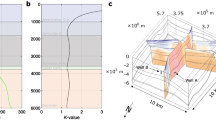Abstract
Injection or withdrawal of fluid at depth may trigger felt seismicity. At a site with natural faults or artificial fracturing cracks, understanding how to avoid triggering felt earthquakes plays a crucial role in the success of underground anthropogenic activities, such as subsurface energy storage and CO2 geological sequestration. With the application of a hydromechanical coupling finite element model, we examine the potential of injection-induced pore pressure change and the responding fault slippage along the fault surface in two injection scenarios: multi-layer injection (MLI) and single-layer injection (SLI). The results indicate that fault slippage buildup is mainly located along the portion of the fault intersecting the reservoir. MLI leads to a relatively lower level of induced seismicity compared with SLI. In the fault zone, the external zone and core of the fault exert a connection effect and barrier effect on the hydraulic connectivity, respectively. After 20 years of injection, the pore pressure in the core presents a smaller change than that in the internal and external zones. Furthermore, an uncertainty analysis was performed to evaluate the statistical significance of permeability in the caprock, reservoir, and fault (core, internal zone, and external zone), and only the permeability in the reservoir significantly affects the level of fault slippage based on the fault zone hydromechanics associated with subsurface energy storage and CO2 geological sequestration.







Similar content being viewed by others
References
Ake J, Mahrer K, O’Connell D, Block L (2005) Deep-injection and closely monitored induced seismicity at paradox valley, Colorado. Bull Seismol Soc Am 95:664–683
Biot MA (1956) Theory of propagation of elastic waves in a fluid-saturated porous solid. I. Low-frequency range. J Acoust Soc Am 28:168–178
Bohloli B, Choi JC, Skurtveit E, Grande L, Park J, Vannest M (2015) Criteria of fault geomechanical stability during a pressure build-up. IEAGHG report 2015/04. Cheltenham, UK
Box GE, Hunter JS (1957) Multi-factor experimental designs for exploring response surfaces. Ann Math Stat 18:195–241
Cameron DA, Durlofsky LJ (2012) Optimization of well placement, CO2 injection rates, and brine cycling for geological carbon sequestration. Int J Greenh Gas Control 10:100–112. doi:10.1016/j.ijggc.2012.06.003
Cappa F, Rutqvist J (2011a) Impact of CO2 geological sequestration on the nucleation of earthquakes. Geophys Res Lett 38:L17313. doi:10.1029/2011gl048487
Cappa F, Rutqvist J (2011b) Modeling of coupled deformation and permeability evolution during fault reactivation induced by deep underground injection of CO2. Int J Greenh Gas Control 5:336–346
Carcione JM, Da Col F, Currenti G, Cantucci B (2015) Modeling techniques to study CO2-injection induced micro-seismicity. Int J Greenh Gas Control 42:246–257. doi:10.1016/j.ijggc.2015.08.006
Chen Z, Liao X, Zhao X, Feng X, Zang J, He L (2015) A new analytical method based on pressure transient analysis to estimate carbon storage capacity of depleted shales: a case study. Int J Greenh Gas Control 42:46–58. doi:10.1016/j.ijggc.2015.07.030
Class H et al (2009) A benchmark study on problems related to CO2 storage in geologic formations. Comput Geosci 13:409–434. doi:10.1007/s10596-009-9146-x
Cody BM, Baù D, González-Nicolás A (2015) Stochastic injection-strategy optimization for the preliminary assessment of candidate geological storage sites. Hydrogeol J 23:1229–1245. doi:10.1007/s10040-015-1250-5
Cornet FH (2016) Seismic and aseismic motions generated by fluid injections. Geomech Energy Environ 5:42–54
Coussy O (2004) Poromechanics. Wiley, New York
Davis SD, Pennington WD (1989) Induced seismic deformation in the Cogdell oil field of west Texas. Bull Seismol Soc Am 79:1477–1495
Dempsey D, Kelkar S, Pawar R, Keating E, Coblentz D (2014) Modeling caprock bending stresses and their potential for induced seismicity during CO2 injection. Int J Greenh Gas Control 22:223–236. doi:10.1016/j.ijggc.2014.01.005
Dempsey D, O’Malley D, Pawar R (2015) Reducing uncertainty associated with CO2 injection and brine production in heterogeneous formations. Int J Greenh Gas Control 37:24–37
Doughty C (2009) Investigation of CO2 plume behavior for a large-scale pilot test of geologic carbon storage in a saline formation. Transp Porous Media 82:49–76. doi:10.1007/s11242-009-9396-z
Ellsworth WL (2013) Injection-induced earthquakes. Science 341:142–150. doi:10.1126/science.1225942
Figueiredo B, Tsang C-F, Rutqvist J, Bensabat J, Niemi A (2015) Coupled hydro-mechanical processes and fault reactivation induced by CO2 injection in a three-layer storage formation. Int J Greenh Gas Control 39:432–448. doi:10.1016/j.ijggc.2015.06.008
Fujii T, Funatsu T, Oikawa Y, Sorai M, Lei X (2015) Evolution of permeability during fracturing processes in rocks under conditions of geological storage of CO2. Mater Trans 56:679–686
Genmo Z, Huaran C, Shuqin M, Deyuan Z (1995) Research on earthquakes induced by water injection in China. Induced seismicity. Springer, Berlin, pp 59–68
Gerstenberger M et al (2013) Induced seismicity and its implications for CO2 storage risk. IEAGHG report 2013/09. Cheltenham, UK
Guglielmi Y, Cappa F, Avouac JP, Henry P, Elsworth D (2015) Induced seismicity. Seismicity triggered by fluid injection-induced aseismic slip. Science 348:1224–1226. doi:10.1126/science.aab0476
Handin J, Hager RV Jr, Friedman M, Feather JN (1963) Experimental deformation of sedimentary rocks under confining pressure: pore pressure tests. Bull Am Assoc Pet Geol 47:717–755
Hanks TC (1979) B values and ω − γ seismic source models: implications for tectonic stress variations along active crustal fault zones and the estimation of high-frequency strong ground motion. J Geophys Res Solid Earth 84:2235–2242
Healy JH (1968) The denver earthquakes. Science 161:1301–1310
Hillis RR (2001) Coupled changes in pore pressure and stress in oil fields and sedimentary basins. Pet Geosci 7:419–425
Hoek E (1990) Estimating Mohr-Coulomb friction and cohesion values from the Hoek-Brown failure criterion. International journal of rock mechanics and mining sciences and geomechanics abstracts. Elsevier, Amsterdam, pp 227–229
Hubbert M, Rubey W (1959) Role of fluid pressure in mechanics of overthrust faulting : I. Mechanics of fluid-filled porous solids and its application to overthrust faulting. Geol Soc Am Bull 70:115–166
Huber EJ, Stroock AD, Koch DL (2016) Analysis of a time dependent injection strategy to accelerate the residual trapping of sequestered CO2 in the geologic subsurface. Int J Greenh Gas Control 44:185–198. doi:10.1016/j.ijggc.2015.11.024
Hunter WG, Hunter JS, George E (1978) Statistics for experimenters: an introduction to design, data analysis, and model building. Wiley, New York
IPCC (2005) IPCC special report on carbon dioxide capture and storage. Cambridge, UK
Iversen GR, Norpoth H (1987) Analysis of variance, vol 1. Sage, London
Jaeger JC, Cook NG, Zimmerman R (2009) Fundamentals of rock mechanics. Wiley, New York
Jeanne P, Guglielmi Y, Cappa F, Rinaldi AP, Rutqvist J (2014) The effects of lateral property variations on fault-zone reactivation by fluid pressurization: application to CO2 pressurization effects within major and undetected fault zones. J Struct Geol 62:97–108. doi:10.1016/j.jsg.2014.01.017
Kanamori H, Anderson DL (1975) Theoretical basis of some empirical relations in seismology. Bull Seismol Soc Am 65:1073–1095
Karimnezhad M, Jalalifar H, Kamari M (2014) Investigation of caprock integrity for CO2 sequestration in an oil reservoir using a numerical method. J Nat Gas Sci Eng 21:1127–1137. doi:10.1016/j.jngse.2014.10.031
Khuri AI, Mukhopadhyay S (2010) Response surface methodology. Wiley Interdiscip Rev Comput Stat 2:128–149. doi:10.1002/wics.73
Labuz JF, Zang A (2012) Mohr–Coulomb failure criterion. Rock Mech Rock Eng 45:975–979. doi:10.1007/s00603-012-0281-7
Lee T-C (1996) Pore-pressure rise, frictional strength, and fault slip: one-dimensional interaction models. Geophys J Int 125:371–384
Lei X, Ma S, Chen W, Pang C, Zeng J, Jiang B (2013) A detailed view of the injection-induced seismicity in a natural gas reservoir in Zigong, southwestern Sichuan basin, China. J Geophys Res Solid Earth 118:4296–4311
Lei X, Yu G, Ma S, Wen X, Wang Q (2008) Earthquakes induced by water injection at ~3 km depth within the Rongchang gas field, Chongqing, China. J Geophys Res Solid Earth 113:B10310. doi:10.1029/2008JB005604
Li Q, Liu G, Liu X, Li X (2013) Application of a health, safety, and environmental screening and ranking framework to the Shenhua CCS project. Int J Greenh Gas Control 17:504–514. doi:10.1016/j.ijggc.2013.06.005
Li Q, Fei W, Liu X, Wei X, Jing M, Li X (2014) Challenging combination of CO2 geological storage and coal mining in the Ordos basin, China. Greenh Gases Sci Technol 4:452–467. doi:10.1002/ghg.1408
Myers RH, Montgomery DC, Anderson-Cook CM (2009) Response surface methodology: process and product optimization using designed experiments, vol 705. Wiley, New York
Nicot J-P, Meckel TA, Carr DA, Oldenburg CM (2014) Impact of induced seismic events on seal integrity, texas gulf coast. Energy Proced 63:4807–4815. doi:10.1016/j.egypro.2014.11.511
Nuzzo RG (2014) Scientific method: statistical errors. Nature 506:150–152
Odell P, Lindsey KC (2010) Uncertainty management in a major CO2 EOR project. In: Abu Dhabi international petroleum exhibition and conference, Abu Dhabi, UAE, 1–4 November, 2010. doi:10.2118/137998-MS
Pan I, Babaei M, Korre A, Durucan S (2014) A multi-period injection strategy based optimisation approach using kriging meta-models for CO2 storage technologies. Energy Proced 63:3492–3499. doi:10.1016/j.egypro.2014.11.378
Peirce JW et al (2004) Is the geosphere secure? Assessing the presence of deep-penetrating faults in the IEA Weyburn CO2 study area, SE Saskatchewan. In: CSPG/CSEG/CWLS Convention 2004, Calgary, Alberta, Canada, May 31–June 4, 2004
Pereira LC, Guimarães LJN, Horowitz B, Sánchez M (2014) Coupled hydro-mechanical fault reactivation analysis incorporating evidence theory for uncertainty quantification. Comput Geotech 56:202–215. doi:10.1016/j.compgeo.2013.12.007
Raleigh C, Healy J, Bredehoeft J (1976) An experiment in earthquake control at Rangely, Colorado. Science 191:1230–1237
Réveillère A, Rohmer J, Manceau J-C (2012) Hydraulic barrier design and applicability for managing the risk of CO2 leakage from deep saline aquifers. Int J Greenh Gas Control 9:62–71. doi:10.1016/j.ijggc.2012.02.016
Rice JR, Cleary MP (1976) Some basic stress diffusion solutions for fluid-saturated elastic porous media with compressible constituents. Rev Geophys Space Phys 14:227–241
Rinaldi AP, Vilarrasa V, Rutqvist J, Cappa F (2015) Fault reactivation during CO2 sequestration: effects of well orientation on seismicity and leakage. Greenh Gases Sci Technol 5:645–656. doi:10.1002/ghg.1511
Roche V, Baan MVD (2014) Geomechanical modeling of induced seismicity due to fluid injection. GeoConvention 283-GC2014:1–4
Rohmer J, Allanic C, Bourgine B (2014) Improving our knowledge on the hydro-chemo-mechanical behaviour of fault zones in the context of CO2 geological storage. Energy Proced 63:3371–3378. doi:10.1016/j.egypro.2014.11.366
Rohmer J, Loschetter A, Raucoules D, de Michele M, Raffard D, Le Gallo Y (2015) Revealing the surface deformation induced by deep CO2 injection in vegetated/agricultural areas: the combination of corner-reflectors, reservoir simulations and spatio-temporal statistics. Eng Geol 197:188–197. doi:10.1016/j.enggeo.2015.08.005
Rozhko A, Tronvoll J (2010) Scaling of fluid-induced seismicity by coulomb stress transfer model. In: 72nd EAGE conference and exhibition incorporating SPE EUROPEC 2010, Barcelona, Spain, 14 June 2010. doi:10.3997/2214-4609.201400773
Rudnicki JW, Rice JR (2006) Effective normal stress alteration due to pore pressure changes induced by dynamic slip propagation on a plane between dissimilar materials. J Geophys Res 111:B10308. doi:10.1029/2006jb004396
Scholz CH (2002) The mechanics of earthquakes and faulting. Cambridge University Press, Cambridge
Shamshiri H, Jafarpour B (2012) Controlled CO2 injection into heterogeneous geologic formations for improved solubility and residual trapping. Water Resour Res 48:W02530. doi:10.1029/2011wr010455
Shapiro S, Patzig R, Rothert E, Rindschwentner J (2003) Triggering of seismicity by pore-pressure perturbations: permeability-related signatures of the phenomenon. Pure appl Geophys 160:1051–1066
Shen X (2010) Examples and applications of ABAQUS in energy engineering. China Machine Press, Beijing
Sorai M, Lei X, Nishi Y, Ishido T, Nakao S (2015) CO2 geological storage. In: Handbook of climate change mitigation and adaptation. Springer, New York. doi:10.1007/978-1-4614-6431-0_85-1
Streit JE, Cox SF (2001) Fluid pressures at hypocenters of moderate to large earthquakes. J Geophys Res Solid Earth (1978–2012) 106:2235–2243
Streit JE, Hillis RR (2004) Estimating fault stability and sustainable fluid pressures for underground storage of CO2 in porous rock. Energy 29:1445–1456. doi:10.1016/j.energy.2004.03.078
Terzaghi K (1943) Theoretical soil mechanics, 1st edn, vol 528. Wiley, New York
Urpi L, Rinaldi AP, Rutqvist J, Cappa F, Spiers CJ (2016) Dynamic simulation of CO2-injection-induced fault rupture with slip-rate dependent friction coefficient. Geomech Energy Environ. doi:10.1016/j.gete.2016.04.003
Vilarrasa V (2014) Impact of CO2 injection through horizontal and vertical wells on the caprock mechanical stability. Int J Rock Mech Min Sci 66:151–159. doi:10.1016/j.ijrmms.2014.01.001
Vilarrasa V, Carrera J (2015) Geologic carbon storage is unlikely to trigger large earthquakes and reactivate faults through which CO2 could leak. Proc Natl Acad Sci 112:5938–5943
Wei XC, Li Q, Li X-Y, Sun Y-K (2015a) Impact indicators for caprock integrity and induced seismicity in CO2 geosequestration: insights from uncertainty analyses. Nat Hazards 81:1–21. doi:10.1007/s11069-015-2063-5
Wei XC, Li Q, Li X-Y, Sun Y-K, Liu XH (2015b) Uncertainty analysis of impact indicators for the integrity of combined caprock during CO2 geosequestration. Eng Geol 196:37–46. doi:10.1016/j.enggeo.2015.06.023
Yamashita T (2007) Postseismic quasi-static fault slip due to pore pressure change on a bimaterial interface. J Geophys Res 112:B05304. doi:10.1029/2006jb004667
Yang D, Zeng R, Zhang Y, Wang Z, Wang S, Jin C (2012) Numerical simulation of multiphase flows of CO2 storage in saline aquifers in Daqingzijing oilfield, China. Clean Techn Environ Policy 14:609–618. doi:10.1007/s10098-011-0420-y
Zhou X, Burbey TJ (2014a) Deformation characteristics of a clayey interbed during fluid injection. Eng Geol 183:185–192. doi:10.1016/j.enggeo.2014.10.001
Zhou X, Burbey TJ (2014b) How horizontal surface deformation during fluid injection correlates to reservoir permeability setting. Environ Eng Geosci 3:305–320
Zhou X, Burbey TJ (2014c) Pore-pressure response to sudden fault slip for three typical faulting regimes. Bull Seismol Soc Am 104:793–808
Zhu Q, Zhou Q, Li X (2016) Numerical simulation of displacement characteristics of CO2 injected in pore-scale porous media. J Rock Mech Geotech Eng 8:87–92. doi:10.1016/j.jrmge.2015.08.004
Zoback MD, Gorelick SM (2012) Earthquake triggering and large-scale geologic storage of carbon dioxide. Proc Natl Acad Sci USA 109:10164–10168. doi:10.1073/pnas.1202473109
Acknowledgments
We acknowledge the funding support from National Natural Science Foundation of China (Grant No. 41274111). Xiaying Li thanks to the Grant of China Scholarship Council for collaborative research in AIST Japan.
Author information
Authors and Affiliations
Corresponding author
Additional information
This article is part of a Topical Collection in Environmental Earth Sciences on “Subsurface Energy Storage,” guest edited by Sebastian Bauer, Andreas Dahmke, and Olaf Kolditz.
Appendix
Rights and permissions
About this article
Cite this article
Wei, X., Li, Q., Li, X. et al. Modeling the hydromechanical responses of sandwich structure faults during underground fluid injection. Environ Earth Sci 75, 1155 (2016). https://doi.org/10.1007/s12665-016-5975-9
Received:
Accepted:
Published:
DOI: https://doi.org/10.1007/s12665-016-5975-9




